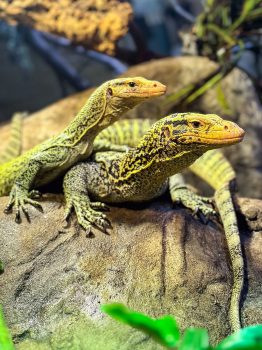Quince Monitor
Common Name: Quince Monitor
Scientific Name: Varanus melinus
Names: Odin & Freyja
Locations: Whitby

Diet
Quince Monitors are carnivorous, feeding primarily on insects, small mammals, birds, and other reptiles.
Average lifespan
In the wild, Quince Monitors can live around 10 to 15 years, though they may live longer in captivity with proper care.
Size
Quince Monitors can reach lengths of up to 1.2 meters (4 feet) from snout to tail.
Weight
Adult Quince Monitors typically weigh between 1.5 to 3 kilograms (3.3 to 6.6 pounds).
About
Quince Monitors are native to the islands of Halmahera and Ternate in Indonesia. They inhabit tropical rainforests and coastal areas, where they can find a variety of prey and suitable basking sites. Their bright yellow coloration with dark spots makes them visually striking.
Size and behavior
Quince Monitors have a slender body with a long tail and strong limbs adapted for climbing. They are diurnal and highly active, often seen basking in the sun or foraging for food. They are excellent climbers and swimmers, making use of their agility to escape predators and hunt effectively.
Diet and nutrition
In the wild, Quince Monitors prey on a variety of small animals, using their keen senses to locate and capture food. In captivity, they should be fed a diet of appropriately sized insects (like crickets and mealworms), small rodents, birds, and occasionally eggs. Providing a varied diet ensures they receive the necessary nutrients for growth and health.
Conservation status
The conservation status of Quince Monitors is not well-documented, but they may face threats from habitat loss and hunting in their native range. Conservation efforts focusing on habitat preservation and protection from hunting are important for their continued survival.
Fun fact
Quince Monitors are known for their striking bright yellow coloration, which becomes more pronounced with age. This vivid color not only makes them a standout species but also serves as a form of camouflage among the sun-dappled leaves and branches of their forest habitat, helping them blend in while hunting or evading predators.
Call or visit your local Reptilia Facility to learn how you can adopt one of these amazing reptiles.










